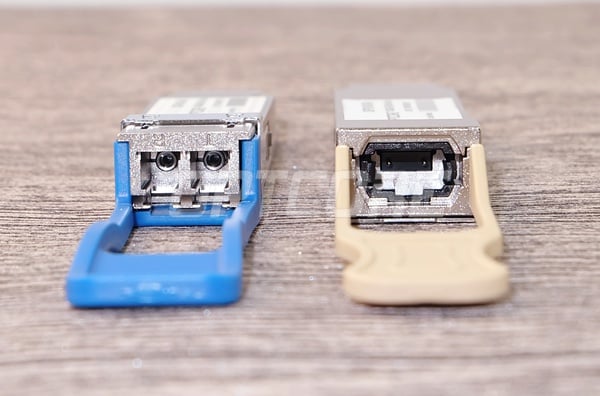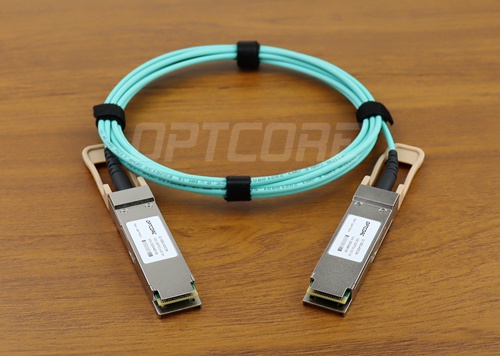Optical Transceiver
100G Transceiver, DAC, or AOC: Which one to Choose?
When you want to buy a 100G transceiver, DAC, or AOC, it can be challenging to figure out which will meet your needs the best. All three 100G modules have their unique benefits and drawbacks, so it can be tough to determine which one is right for you. This article will look at these three options and help you decide the best fit for your needs.
Table of Contents
- 100G Transceiver
- 100G DAC Cable
- 100G AOC Cable
- 100G Transceiver vs. DAC vs. AOC, Which one to Choose?
- Conclusion
100G Transceiver
For 100G data center connectivity, 100G transceivers are standard options. According to the form factors, the 100G transceiver mainly includes QSFP28, CFP, CFP2, CFP4, SFP56-DD, and DCO modules. According to the transmission mode, it can be divided into 100GBASE-SR4, 100GBASE-LR4, 100GBASE-ER4, 100GBASE-ZR4, 100GBASE-PSM4, 100GBASE-BiDi, 100GBASE-DR and 100GBASE-FR.

The QSFP28 transceiver is the most commonly used form factor for data center applications. It provides various product combinations, such as 100GBASE-SR4 QSFP28, 100GBASE-PSM4 QSFP28, 100GBASE-LR4 QSFP28, 100GBASE-ER4 QSFP28, and 100GBASE-ZR4 QSFP28 optical module.
100GBASE-SR4 and 100GBASE-PSM4 QSFP28 feature MPO/MTP connectors to support multi-mode or Singlemode fiber cabling. The other 100G QSFP28 module uses an LC connector to support the traditional single mode fiber cabling.
100G SR4 and LR4 are the most commonly used transceiver for data center applications. Their pricing is decreasing month by month. For example, the prices of 100G SR4 QSFP28 were more than $1,500 when they were first introduced. But now you can get them for less than $100 from the supplier.
100G DAC Cable
When it comes to 100G DAC cables, there are a few options to choose from. The two most common types are passive and active types. Each type of cable has its advantages and disadvantages, which will be explored in this article.

100G Passive copper cables are the most common type of 100G DAC cable and are usually used for short distances. They have a low price point and deliver good performance, but their distance range of 5 meters limits them.
100G active copper cables are a newer technology and are becoming more efficient for their increased distance range of up to 10 meters. They have a higher price point but offer better performance for their increased capacity.
Another type is a hybrid 100G DAC cable. This type of cable comprises different connectors and data rates on both ends of the cable. For example, one end might be an SFP28 for 25G Ethernet, and the other could be a QSFP28 for 100G Ethernet. This cable is helpful for those who need to interconnect the switch ports.
When choosing a 100G DAC cable, it is crucial to consider the length of the run, the data rate of the devices, and the budget. For short runs, passive copper cables are a good option. Active copper cables might be a better option for longer runs or devices requiring high data rates.
No matter what type of 100G DAC cable you choose, you can be sure it will provide a fast and reliable connection.
100G AOC Cable
The active optical cable (AOC) is a cable that uses an optical fiber link between two active devices. 100G AOC is different from the direct-attached cable (DAC) because it uses an optical transceiver at each end, which converts the electrical signal to an optical signal and vice versa.

Also, AOCs are typically thinner and lighter than DACs, which is an advantage in high-density applications. They also have a long-distance range, typically up to 100 meters. The disadvantage is that they are more expensive than copper cables.
The most common type of 100G AOC is the QSFP28 AOC, which uses 4 parallel fibers to attain a data rate of 100 Gbps. It is commonly used in data centers for connecting servers and storage devices. If cost and price are not considered, 100G AOC provides the best performance and is suitable for most data center and cloud computing applications.
100G Transceiver vs. DAC vs. AOC, Which one to Choose?
Concerning 100G, there are three main options: transceivers, DACs, and AOCs. But which one is right for you?
The first step is to figure out what your needs are. What kind of data do you need to transmit? How far will it need to travel? What are the environmental conditions?
Once you understand your needs well, you can start narrowing down your choices. A transceiver is probably your best bet if you need to transmit large amounts of data quickly over long distances (>100m). An AOC might be better if you transfer data in a tight space or in challenging environmental conditions.
Ultimately, the best way to decide between these three choices is to talk to a professional. They can help you figure out which option is best for your needs and give you tips on using your 100G connection to its fullest.
The most important thing is how to balance cost and demand. If you are not sure about the future development of your project, it is suggested to choose a device with low cost and high compatibility. DAC or AOC is recommended in this situation. However, a transceiver should be your top pick if you have special requirements or a large budget.
The below table provides a general guide for your selection:
| Comparison | 100G DAC | 100G AOC | 100G Transceiver |
| Reach | Passive: max 5m Active: max 10m | Max 100m | 100GBASE-SR4: 100m 100GBASE-LR4: 10km 100GBASE-ER4: 40km 100GBASE-ZR4: 80km |
| Fiber Type | Copper Cable | OM3/OM4 Fiber Cable | OM3/OM4/OS2 Fiber Cable |
| DOM Support | No | Yes | Yes |
| Compatibility | Yes | Yes | Yes |
| Power Consumption | Lowest | Medium | Highest |
| Weight | 150g~1kg | 100g~5kg | ~50g |
| Price (Optcore) | Lowest | Medium | Highest |
| Size | Big | Medium | Small |
| Application | EoR Switch to Server | ToR Switch to Server EoR Switch to Server | ToR Switch to Server EoR Switch to Server Data Center Interconnection |
Conclusion
In conclusion, each type of 100G connection has advantages and disadvantages. 100G DAC is mainly for very short-distance connectivity and costs less. 100G AOCs have a more extended transmission range but are more expensive than DACs. 100G Transceivers offer the same performance for more extended reach and have the most flexibility for different applications, but they are also the most expensive.
Do you know now which 100G optics is the better choice for you? If not, please leave your comment below or contact us for professional help.
Read more:
- OPTCORE 100G QSFP28 Transceiver Solution
- 10 Terms You Need to Know for 100G Transceiver Optics?
- 40G QSFP+ vs. 100G QSFP28 Transceiver: Pros and Cons
- All Things You Should Know about 100G Transceivers







